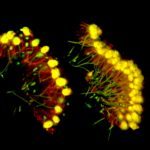Link to Pubmed [PMID] – 31624206
Link to DOI – 10.1126/science.aay2346
Science 2019 Oct; 366(6463): 326-334
Collective cell contractions that generate global tissue deformations are a signature feature of animal movement and morphogenesis. However, the origin of collective contractility in animals remains unclear. While surveying the Caribbean island of Curaçao for choanoflagellates, the closest living relatives of animals, we isolated a previously undescribed species (here named Choanoeca flexa sp. nov.) that forms multicellular cup-shaped colonies. The colonies rapidly invert their curvature in response to changing light levels, which they detect through a rhodopsin-cyclic guanosine monophosphate pathway. Inversion requires actomyosin-mediated apical contractility and allows alternation between feeding and swimming behavior. C. flexa thus rapidly converts sensory inputs directly into multicellular contractions. These findings may inform reconstructions of hypothesized animal ancestors that existed before the evolution of specialized sensory and contractile cells.

